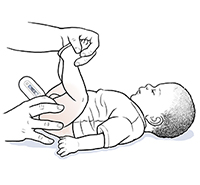Rectal Temperature
A rectal temperature is taken by placing a thermometer in your baby’s bottom. This method provides the most accurate reading. Talk with your baby's healthcare provider before taking your baby's temperature this way. It should be done only when advised by your baby’s healthcare provider.
For infants and toddlers, be sure to use a rectal thermometer correctly. A rectal thermometer may accidentally poke a hole in (perforate) the rectum. It may also pass on germs from the stool. Always follow the product maker’s directions for correct use. If you don’t feel comfortable taking a rectal temperature, use another method. When you talk to your child’s healthcare provider, tell them which method you used to take your child’s temperature.
Getting the thermometer ready
-
Be sure to use a thermometer that is for rectal use.
-
Wipe the thermometer with warm, soapy water, then wipe with clean water. Wipe dry or let the thermometer air-dry.
-
Put a small amount of petroleum jelly or water-based lubricant on the tip.
Positioning your baby
Use the position that works best for you:
-
Put baby on their back on a firm surface. Hold baby’s ankles and lift both legs, as if changing a diaper.
-
Or place baby face down across your lap. Use 1 hand to part baby’s buttocks.

Taking the temperature
Follow the directions for using your specific digital thermometer:
-
Gently slip the tip of the thermometer into the anal opening (where stool leaves the body), no further than 1/2 inch to 1 inch.
-
Hold the thermometer in place until it beeps. Slide the thermometer out. Read the temperature on the digital display.
-
Before putting the thermometer away, clean it with soap and warm water.
-
When you report your baby's temperature to their healthcare provider, make sure you include that the temperature was taken rectally.

Online Medical Reviewer:
Donna Freeborn PhD CNM FNP
Online Medical Reviewer:
Heather M Trevino BSN RNC
Online Medical Reviewer:
Liora C Adler MD
Date Last Reviewed:
2/1/2023
© 2000-2025 The StayWell Company, LLC. All rights reserved. This information is not intended as a substitute for professional medical care. Always follow your healthcare professional's instructions.